L5 Respiration
一、Fundamental concepts of External Respiration
Ventilation , or convection – bulk flow of air or water to and from the gas-exchange membrane during breathing.
The respiration system and important factors:
- Lung, Gill ( 肺)
- Respiration (呼吸)
- Brain stem (脑干)
- Medulla (髓质)
- Rhythm (节奏)
- Alveolus (Alveoli) hollow cavity (肺泡)

- External respiration: 呼吸器官的通气和换气活动合称为外呼吸
- Internal respiration: 组织换气活动称为内呼吸
Fundamental concepts of External Respiration:
- Oxygen always crosses the gas-exchange membrane by diffusion
- Oxygen partial pressure must be lower inside than that on the outside
- The rate of diffusion is in proportion to the area of the membrane
- CO
2, in humans, diffusion is the exclusive mechanism by which it crosses the gas-exchange membrane - In freshwater animals, CO
2is through active transport as HCO3^-^
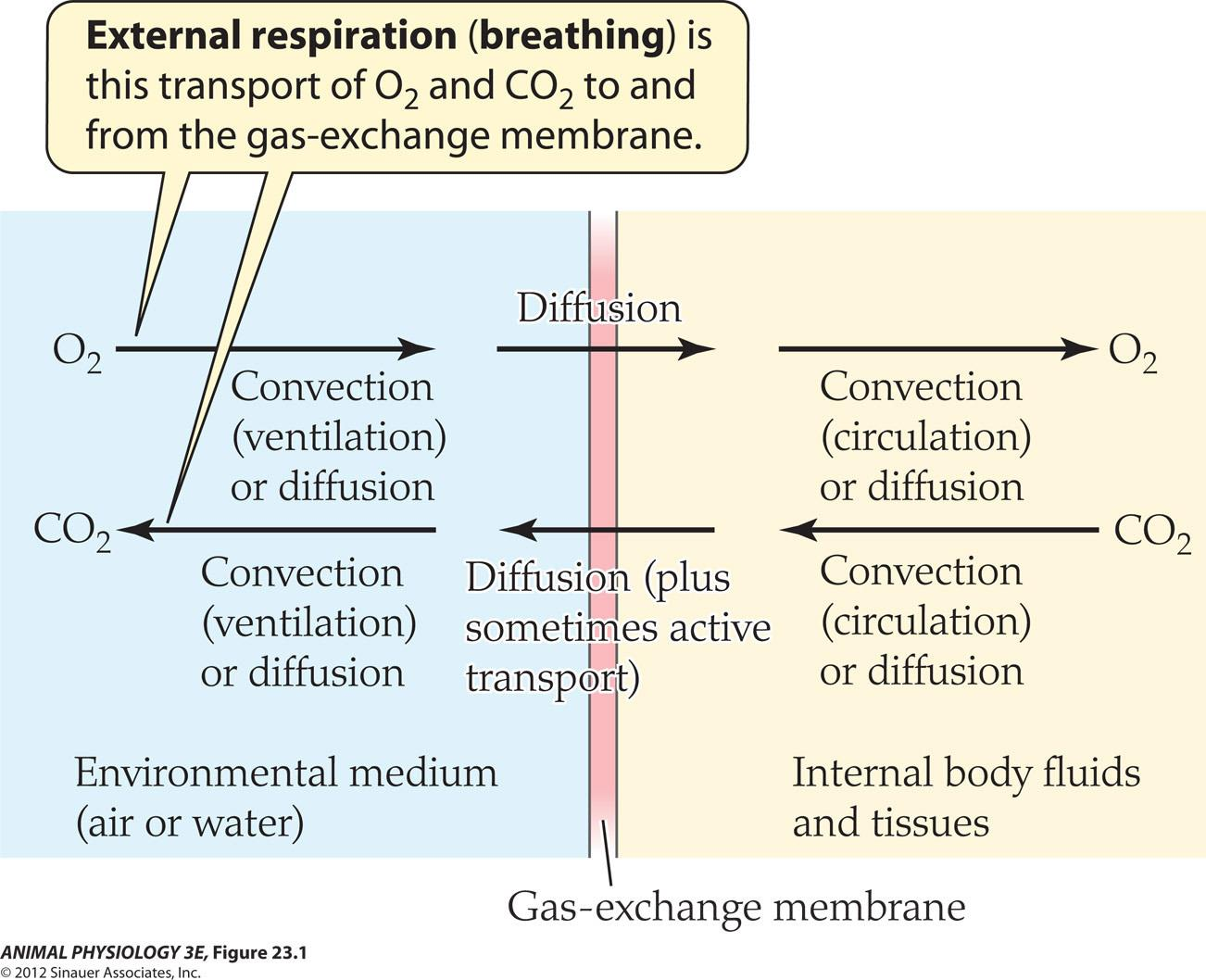

- Lungs are invaginated into the body and contain the environmental medium
- External gills(外鳃) are evaginated from the body and project directly into the environmental medium
- Internal gills(内鳃) are evaginated from the body and project into a superficial body cavity, through which the environmental medium is pumped
Ventilation
Active ventilation (animal creates the ventilatory currents)
- unidirectional (one way flow of air or water to the gas-exchange Membrane)
- tidal (bidirectional) [air or water alternately flows to and from the gas-exchange membrane]
- [mammalian lungs]
- nondirectional (no direction, such as external gills)
Passive ventilation (environmental forces directly or indirectly induce current or air or water to and from the gas-exchange membrane)
Summary
- Oxygen always cross the gas-exchange membrane by diffusion
- High O
2partial pressure moves towards low O2pressure - Breathing organs are gills and lungs
- Ventilation is the forced flow of environmental medium to and from the gas-exchange membrane
二、Principles of gas exchange by active ventilation – internal respiration
Active ventilation
$$
\text{Rate of }O_{2} \text{ intale (ml }O_{2} \text{/minute)} = V_{\text{medium}}(C_{I} - C_{E})
$$
$$
V_{\text{medium}} = \text{rate of flow (L/min) of air or water}
$$
- C
Iis the inhaled medium (mL O2/L medium) O2concentration - C
Eis the exhaled medium (mL O2/L medium) O2concentration
Percent of oxygen removed from the inhaled medium is called Oxygen extraction coefficient = 100(CI-CE )/CI
- Example: water entering the mouth of a fish with 6 mL O2/L and exiting the gills Contains 4 mL O2/L and the rate of ventilation is 0.5 L/min, what is: the rate of O2 uptake?
- The O2 extraction coefficiency?
1. Unidirectional Ventilation

- Cocurrent gas exchange: As blood and medium flow in the same direction, they gradually approach equilibrium with each other
- Countercurrent gas exchange: As blood flows in the direction opposite to the medium and picks up O
2, it steadily encounters medium of higher O2partial pressure, so that a partial-pressure gradient favoring O2, diffusion into the blood is maintained

- Cocurrent gas exchange
- Countercurrent gas exchange
- Cross-current gas exchanges
Tidal Gas Exchange
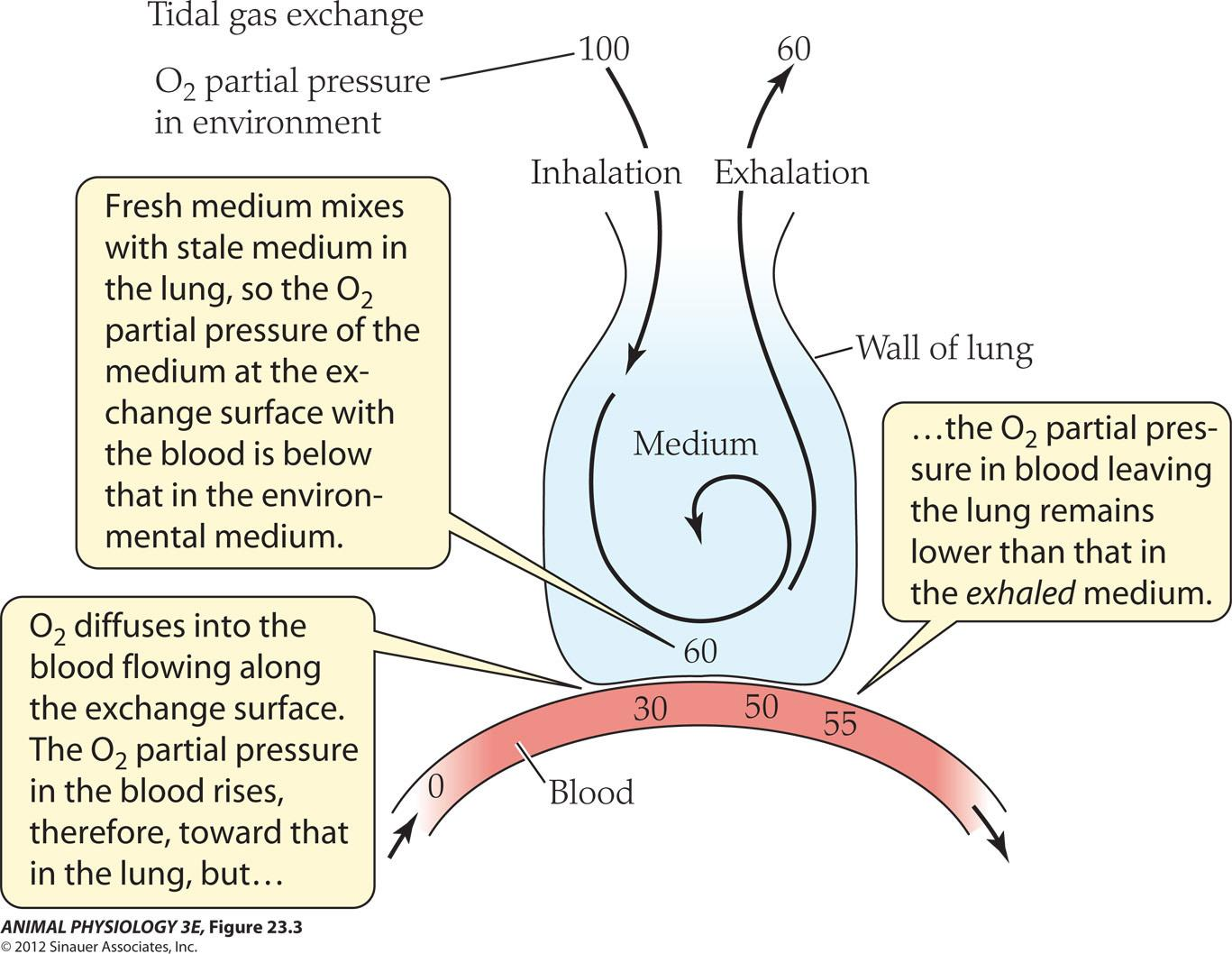
- Fresh medium mixes with stale medium in the lung, so the O2 partial pressure of the medium at the ex change surface with the blood is below that in the environ mental medium
- O2, diffuses into the blood flowing along the exchange surface The O2 partial pressure in the blood rises therefore, toward that in the lung, but the O2 partial pressure in blood leaving the lung remains lower than that in the exhaled medium
Mode of exchange ranking of the efficiency of creating high O2 partial pressure in the blood
- Countercurrent exchange is superior to cross current exchange
- Cross-current exchange is superior to cocurrent or tidal exchange
The solubility of different gases are different in waters
- CO
2has a far higher solubility than O2or N2 - The absorption coefficients of CO
2, O2and N2in cold distilled water are 77, 2.2 and 1.1 mmol/L
CO2 partial pressure changes are dependent on whether air or water is breathed
In water breathers: CO2 partial pressure in the blood leaving the breathing organs is always similar to the CO2 partial pressure in the ambient water, regardless whether The gas-exchange is tidal, cocurrent, countercurrent or cross-current.
- For example, if the ambient water is well aerated with near zero CO
2, the blood is always near zero! Fish in a aerated water, the partial pressure of CO2In blood leaving the gills is typically about 0.3 kPa (2 mm Hg).
In air breathers: the partial pressure of CO2 in blood leaving the lung is more than 10 times the corresponding value in fish (5.3 kPa, 40 mm Hg).
- The property of air and water is Capacitance coefficient ($\beta$) – the change in total gas concentration per unit of change In gas partial pressure.
- In air: both O
2and CO2have the same capacitance coefficient (Universal gas law) - In water: capacitance coefficient for CO
2is 23 times that for O2(partly because of the solubility)
- In air: both O
三、Introduction to vertebrate breathing
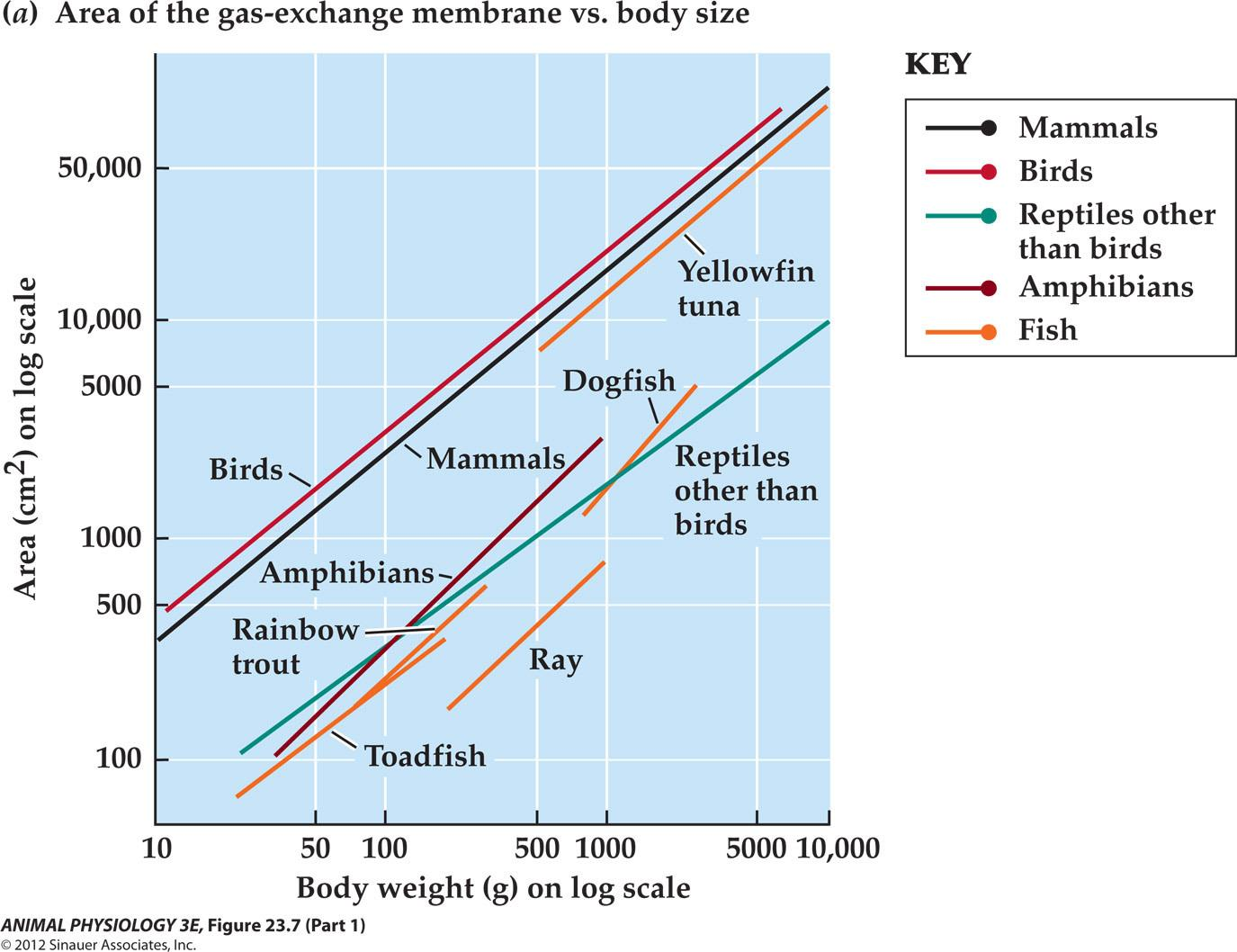

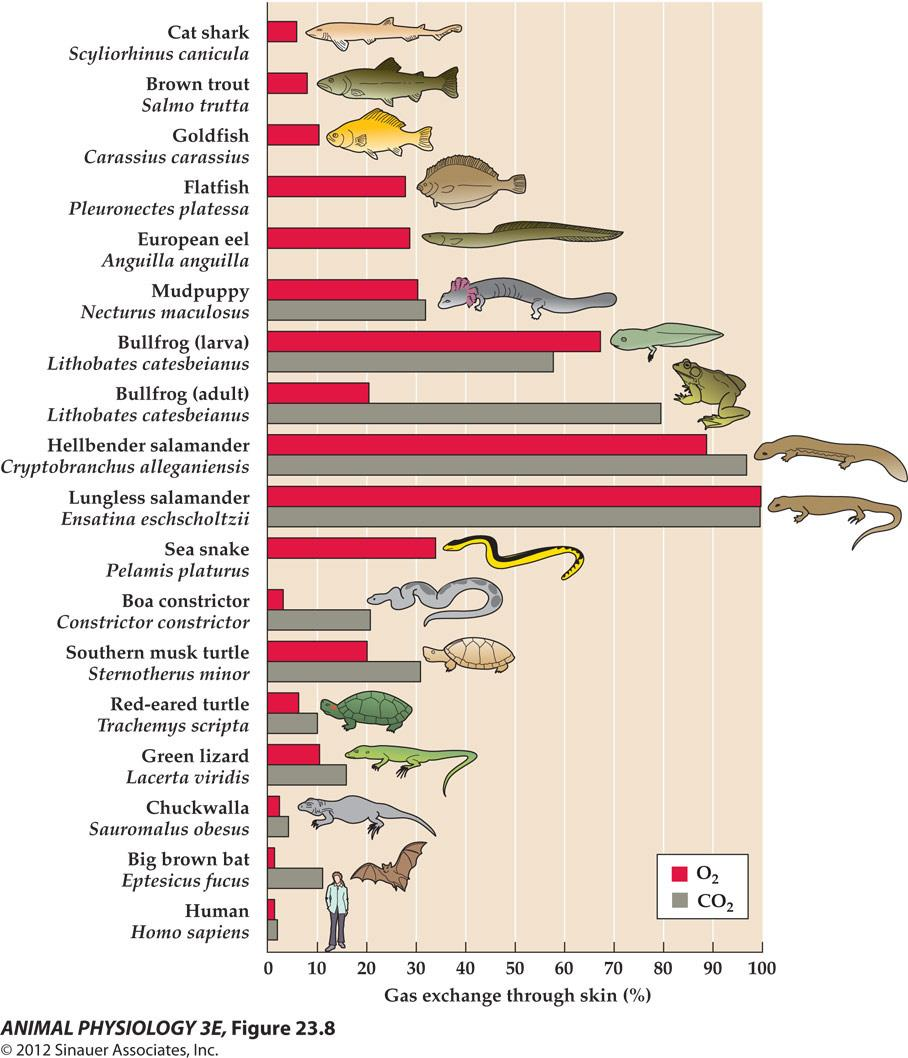
- Skin as a gas-exchange membrane
- 25% of the gas exchange – some fish, Snakes and reptiles;
- 100% of gas exchange across the skin in lungless salamanders
- For terrestrial vertebrates which developed mechanisms against water loss through their skin is poorly permeable to O
2and CO2.
四、Breathing by mammals
The airways in human lungs:
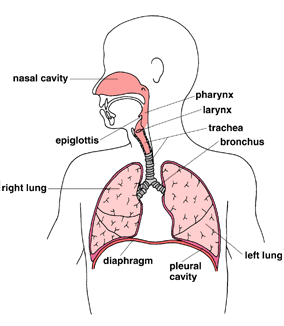
Conducting airways: Trachea, bronchi and most of the bronchioles - for air transport.
- The anatomically dead space
Respiratory airways: respiratory bronchioles,
- Alveolar ducts and alveolar sacs – gas exchange Between blood and gas occurs.


- The trachea divides here to give rise o two major airways, the primary bronchi, that enter the two lungs
Trachea – 23 levels of branching – primary bronchus (two bronchi) enters the two lungs dendritically branching into bronchioles bronchioles end blindly in alveolar ducts and alveolar sacs
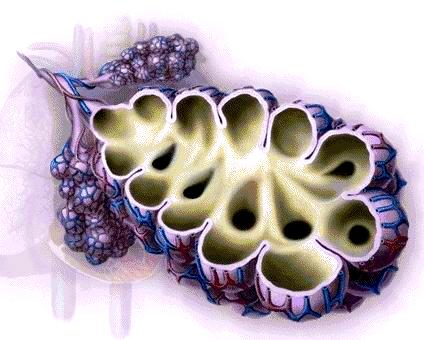
- Alveoli – 300 million alveoli in the lungs of a human adult

- The terminal bronchioles, with diameters of 0.5 mm or less in humans are the final branches of the conducting (nonrespiratory) airway system.
- Alveoli first appear along the respiratory bronchioles and form a continuous lining along the alveolar ducts and sacs
- The walls of the alveoli are richly invested with blood capillaries

- The gases in the alveolar sacs and alveoli are motionless!
- Alveolar sacs are never fully Empted!
- O
2and CO2transport through diffusion. - Alveoli is 0.25 mm in diameter, diffusion is fast (as long as it is filled With air! Not water).
- At the end of a resting exhalation the lung contains 2400 mL of stale air (170 mL is in the anatomical dead space, ie the conducting airways)
Dynamic lung volumes

- 肺活量(VC) Vital capacity
- 潮气量(TV)
- 补呼气量(ERV)
- 补吸气量(IRV)
- 残气量(RV)
- 肺总容量(TLC)
Tidal volume - the volume of air inhaled and exhaled per breath (2900 mL which is the volume of lung – 2400 mL which is at the End of exhalation = 500 mL)
- 平静呼吸的时候每次吸入或者呼出的气量
Resting Expiratory reserve volume - the maximal volume of air one can expel beyond the resting expiratory level. (2400 mL left in the lung – 1200 mL which can be exhaled by efforts = 1200 mL residual volume which can not be exhaled)
- 补呼气量是平静呼气后所能呼出的最大气量
Resting Inspiratory reserve volume – the maximal volume of air can be inhaled beyond the resting inspiratory level. (3100 mL , so the maximal lung volume is about 6000 mL (3100 + 2900)
- 在平静吸气后再作最大吸气动作所能增加的吸气量称为补吸气量
$$
\text{VC = TV + ERV + IRV}
$$
The power for ventilation
The power for ventilation is developed by the diaphragm and the intercostal and abdominal muscles
Relaxation volume – in adult male the volume of gas is about 2400 mL
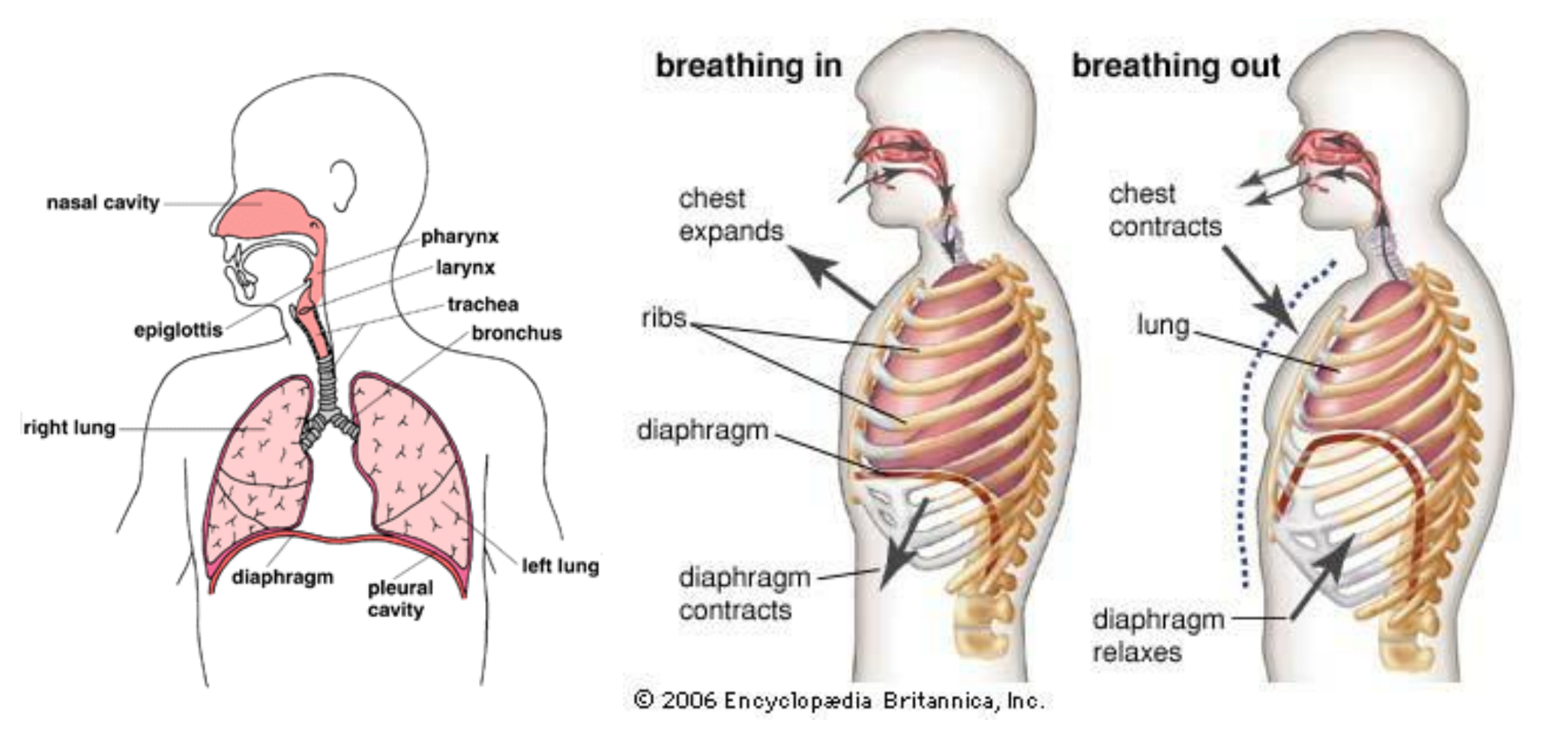
胸膜腔内只有少量的浆液,没有气体:
- 润滑作用,减小摩擦力,两层胸膜可互相滑动。
- 使两层胸膜贴附在一起,不易分开,所以肺就可随着胸廓的运动而运动。
胸膜腔的密闭性和两层胸膜间浆液分子的内聚力有重要生理意义,如果密闭性被破坏,在临床上产生气胸 (pneumothorax)
Control of active ventilation
- The cerebellum deals with sensory perception and motor output.
- The medulla controls involuntary impulses such as breathing, swallowing and coughing.
Hypothesis of Central Control - central pattern generator: Rhythmogenesis - Neural generation of rhythmic behavior
- A set of motor neurons in the brainstem – medulla initiates rhythmic outputs of nerve impulses (action potentials), that underlies a behavior pattern without requiring sensory feedback to trigger the next movement.
- Skeletal muscles requires stimulation by motor neurons for each and every contraction they undergo.
Continuous breathing - Humans and most other mammals - each breath is followed promptly by another breath in a regular uninterrupted rhythm.
Intermittent breathing (periodic breathing) – lizards, snakes, turtles, amphibians – breath or a set of breath are regularly interrupted by extended periods of apnea (a period of no breathing)
[each period of apnea is followed by inspiration, the lungs are therefore inflated during apnea!]

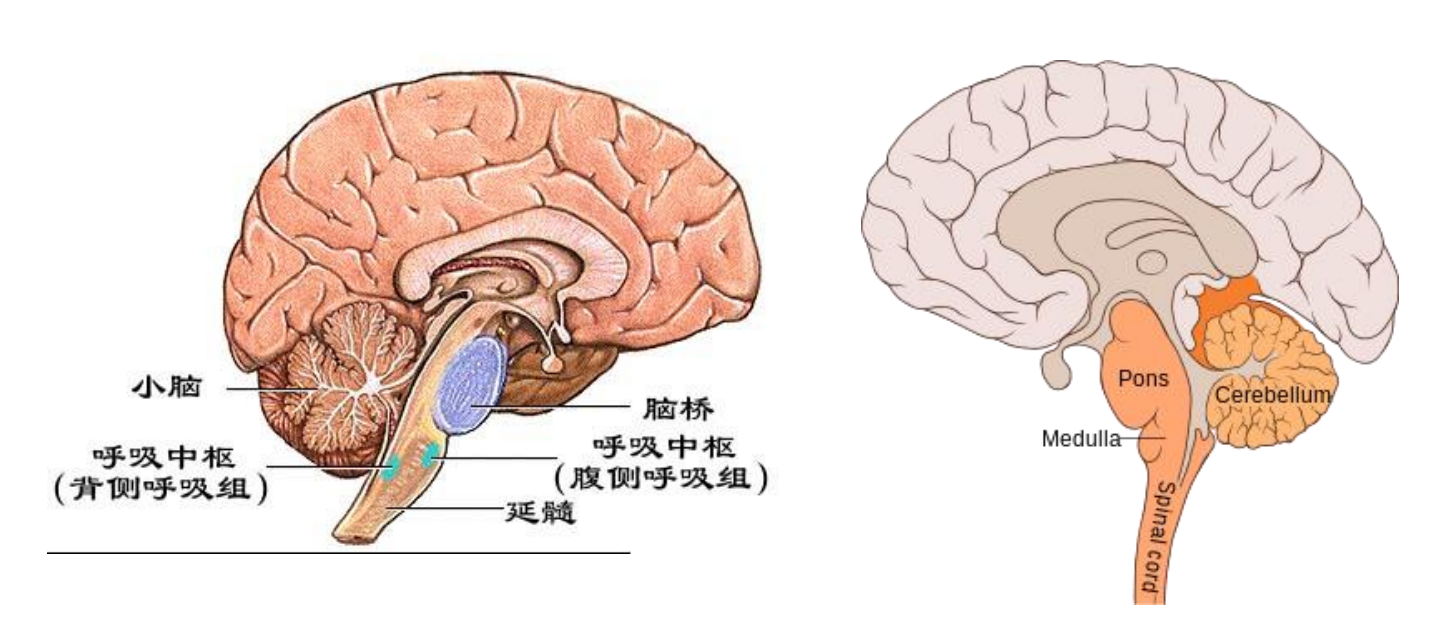
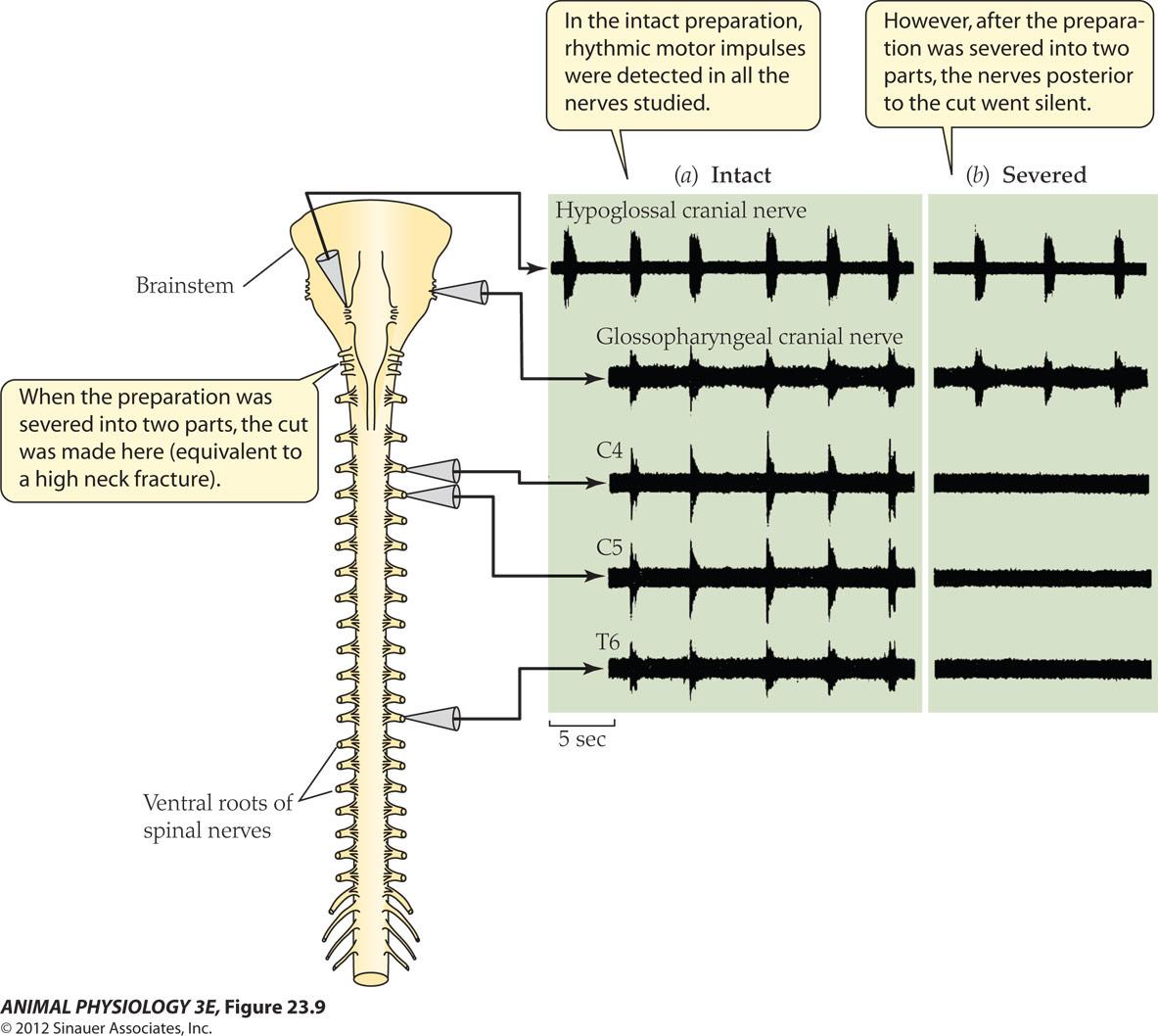
- When the preparation was severed into two parts, the cut was made here (equivalent to a high neck fracture)
- In the intact preparation, rhythmic motor impulses were detected in all the nerves studied
- However, after the preparation was severed into two parts, the nerves posterior to the cut went silent